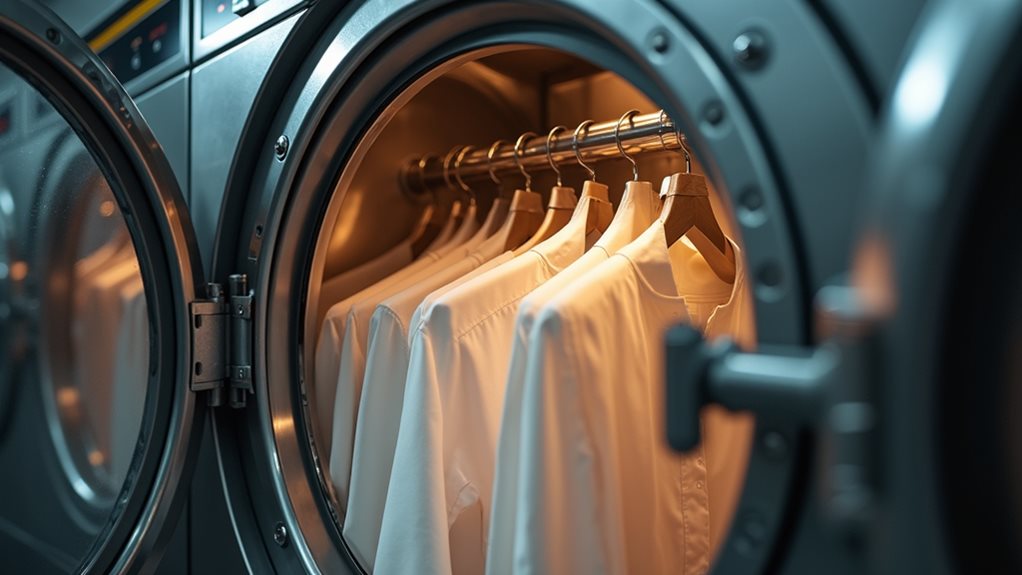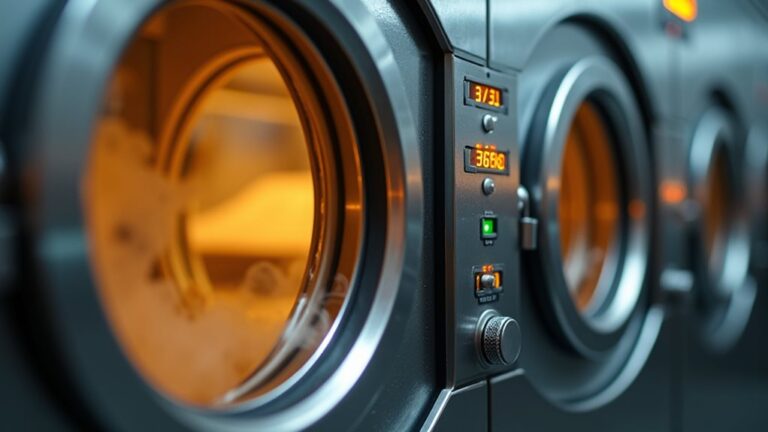Yes, dry cleaning definitely uses heat, though you might be surprised by how strategically it’s applied throughout the process. While the initial solvent cleaning happens at cooler temperatures around 86-104°F, your garments experience notable heat during drying cycles at 140-145°F for sanitization, and finishing presses can reach up to 220°F to eliminate wrinkles and kill bacteria. Understanding these temperature variations helps explain why your delicate fabrics emerge both thoroughly cleaned and professionally finished.
The Role of Heat in Traditional Dry Cleaning Processes
When I first started working at my uncle’s dry cleaning shop during high school summers, I was surprised to discover that despite the name “dry” cleaning, heat plays a crucial role throughout the entire process.
You’ll find that the dry cleaning process relies on carefully controlled temperatures to achieve ideal results without damaging your delicate fabrics. During the drying cycle, garments are tumbled in warm air at 140-145°F, which effectively removes cleaning solvents and moisture while maintaining fabric integrity.
High temperatures are important for proper sanitization, killing harmful pathogens that regular cleaning might miss. The final finishing steps involve pressing or steaming at temperatures up to 220°F, eliminating wrinkles and providing that crisp, professional appearance you expect from quality dry cleaning services.
However, the actual cleaning phase operates at much cooler temperatures between 86-104°F when chemical solvents like perchloroethylene work to clean fabrics without causing damage to delicate materials.
Temperature Control During Solvent-Based Cleaning
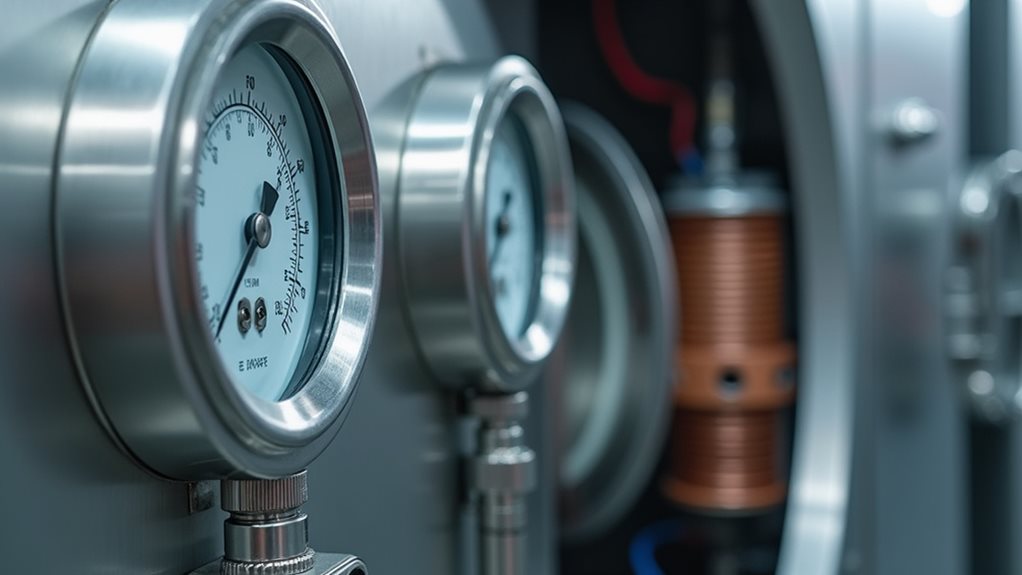
Although the cleaning phase might seem less dramatic than the high-heat finishing stages, proper temperature control during solvent-based cleaning requires just as much precision and expertise.
When your delicate fabrics meet that cleaning solvent at around 30°C, it’s like finding the perfect balance between effectiveness and protection – too hot, and you’ll damage silk; too cool, and stubborn stains won’t budge.
Professional cleaners master this temperature dance through:
- Monitoring solvent temperatures to protect delicate fabrics while maximizing stain removal
- Coordinating mechanical action with controlled heat for peak cleaning results
- Shifting seamlessly from gentle cleaning to the warm air drying process
- Balancing sanitization needs with fabric preservation throughout each cycle
This careful orchestration guarantees your garments receive thorough cleaning without compromising their integrity, setting the stage for high-temperature drying when needed. The controlled temperature approach is particularly crucial for structured garments like suits and formal wear that require specialized handling to maintain their shape and appearance.
Heat Application in Garment Finishing and Pressing
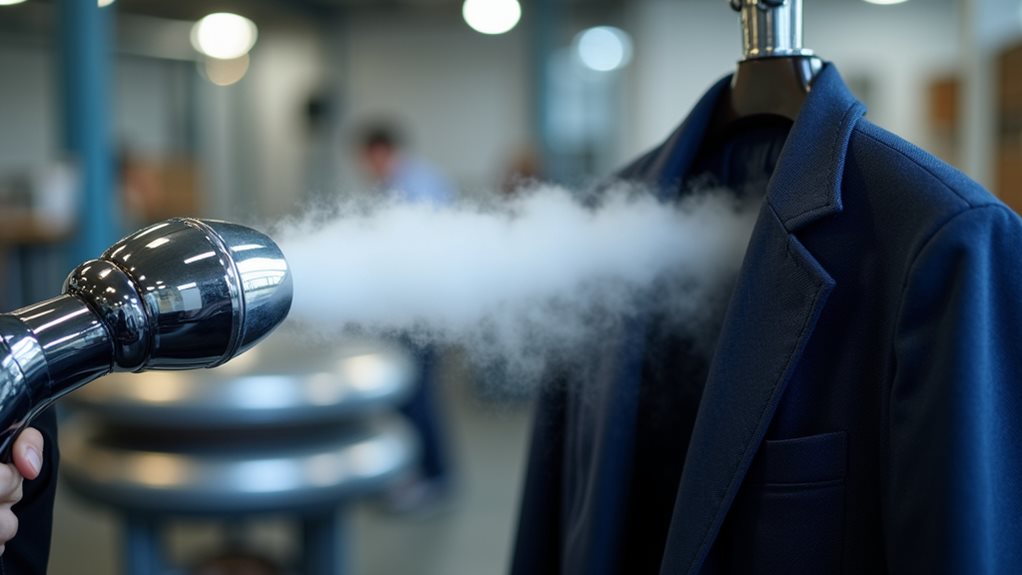
The real magic happens after your garments emerge from their gentle solvent bath, because that’s when professional cleaners fire up the heavy artillery – pressing equipment that can reach a scorching 220°F to transform your wrinkled clothes into crisp, polished perfection.
During this finishing stage, heat application becomes absolutely essential, as high-temperature steam relaxes fabric fibers while pressed surfaces eliminate every stubborn wrinkle.
What’s fascinating is how these heightened temperatures don’t just improve appearance – they’re actually killing bacteria and removing residual moisture that could cause problems later.
However, skilled technicians must carefully monitor delicate fabrics, because excessive heat can spell disaster for your favorite silk blouse or cashmere sweater, potentially causing shrinkage that’ll make you question your life choices.
Temperature precision protects garment integrity while delivering that professional finish you’re paying for.
This heat-intensive finishing process ensures that garments maintain their shape and structure, which is one of the key advantages that makes dry cleaning superior to traditional water-based washing for structured garments with special construction details.
Drying Cycles and Thermal Requirements
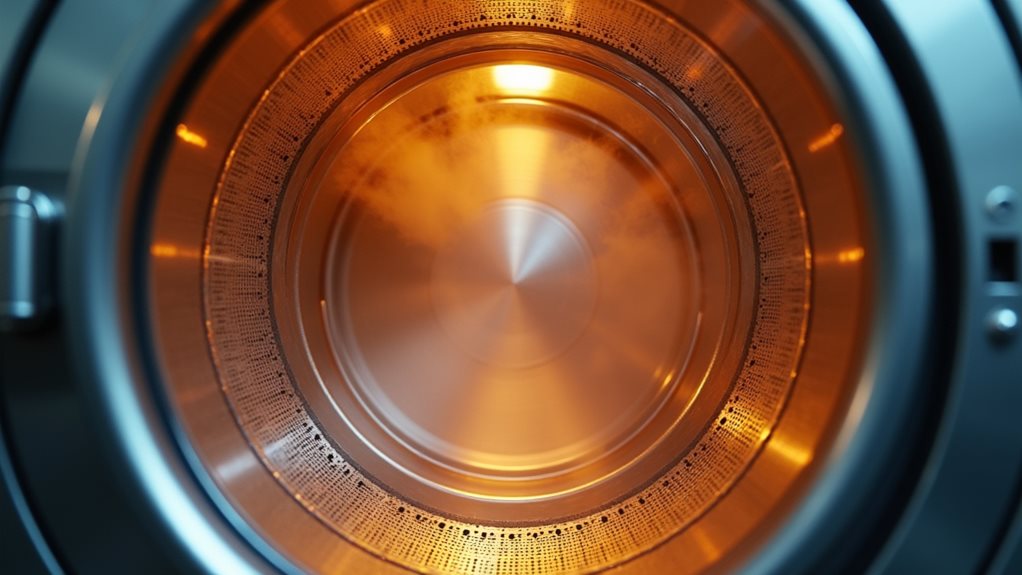
Two distinct phases make up the drying process in dry cleaning, and honestly, understanding these thermal requirements helped me appreciate why my favorite wool coat always comes back looking absolutely pristine.
The drying cycles use warm air at temperatures between 140–145°F, creating perfect conditions for removing residual solvents while protecting delicate fabrics.
The carefully controlled 140–145°F temperature range ensures complete solvent elimination while safeguarding even the most delicate fabric fibers.
Here’s what makes these thermal requirements so effective:
- Sanitization boost – Higher temperatures up to 220°F kill viruses and pathogens
- Solvent removal – Warm air circulation eliminates chemical residues completely
- Fabric protection – Controlled heat prevents distortion while maintaining texture
- Mechanical action – Combined movement and warmth guarantees thorough cleaning
You’ll notice how this careful temperature control, combined with precise solvent use and gentle mechanical action, delivers exceptional results without fabric distortion or damage.
After the cleaning and drying phases, professional facilities use distillation process techniques to purify and recycle the cleaning solvents for environmental efficiency and cost-effectiveness.
Heat Considerations for Different Fabric Types
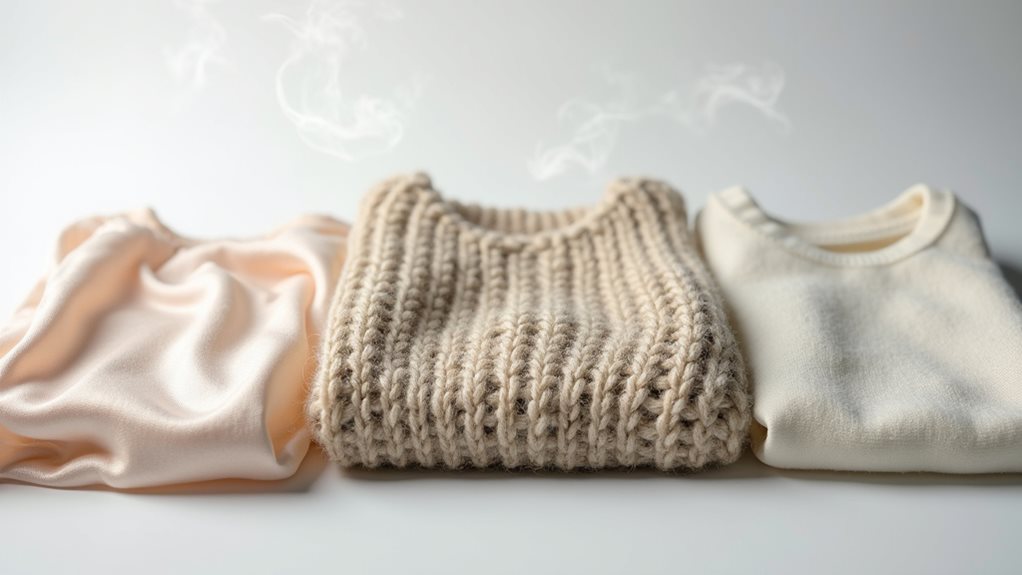
When I first started paying attention to fabric care labels, I realized that dry cleaners don’t just blast every garment with the same heat treatment – they’re actually fabric whisperers who adjust temperatures based on what you’re wearing.
Your delicate silk blouse gets the gentle treatment with lower heat during the drying cycle, while your sturdy cotton blazer can handle more intense warm air without flinching.
These professionals know that bacteria elimination requires careful balance – enough heat to sanitize, but not so much that your favorite cashmere sweater becomes a doll outfit 😅.
During pre-treatment and steaming phases, they’ll dial down temperatures for sensitive fabric types, guaranteeing cleaning agents work effectively without turning your investment pieces into expensive mistakes.
However, when it comes to stubborn sweat stains, the chemical solvents used in dry cleaning may not be as effective as water-based treatments since perspiration marks are primarily water-soluble.

